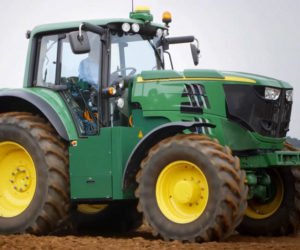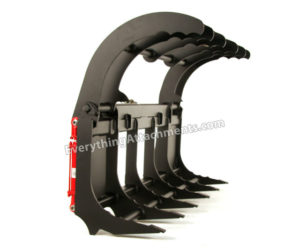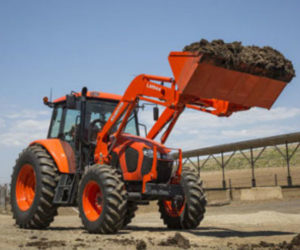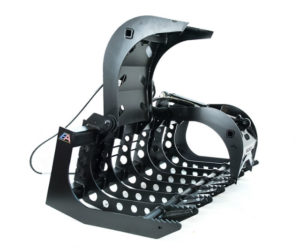Electric Tractors and Attachments

 While the main advancements in farm equipment for the past decade have focused on developing precision agriculture, engineers haven’t been sitting idly, expecting technology to do all the work. Equipment manufacturers around the world are experimenting with ways for electrical equipment to improve tractors and implements.
While the main advancements in farm equipment for the past decade have focused on developing precision agriculture, engineers haven’t been sitting idly, expecting technology to do all the work. Equipment manufacturers around the world are experimenting with ways for electrical equipment to improve tractors and implements.
“Electrification is coming – if we can figure out how to keep the price down,” says Tim Stombaugh, an Extension professor of machine systems automation engineering at the University of Kentucky. “It is more efficient, is quieter, requires less maintenance, is more controllable, and is potentially safer and lighter.”
There are two main experiments being conducted on how electric power can be used: one for diesel-electric tractors and one for battery-powered tractors.
DIESEL-ELECTRIC TRACTORS
Back in 2001, Fendt and AGCO began intensively researching how electric power generated by an electric tractor could be transferred to an implement. In 2013, the results of that work went on display for the first time when Fendt presented the X Concept tractor at Agritechnica.
The X Concept is powered by AGCO’s Power four-cylinder diesel engine. The compact design of the engine allows the tractor to accommodate the necessary components for the electrical technology, including a high-performance alternator, power electronics, wiring, and the specialist heat exchanger.
The electrical systems within the X Concept – dubbed the Powerbus – can provide up to 174 hp. to implements through a compact power socket. The system also provides power to the internal tractor, including the electrical fan drive and the coolant pumps.
To see how this prototype could work on the farm, Fendt also needed to develop a high-voltage, electrically powered implement. Two years ago, Fendt introduced another prototype: an electric-driven rotary rake called the Former 12555 X.
“We are confident that electricity will be used more and more in agriculture. This is one example from Fendt,” says Stephan Bea, head of sales engineering at Fendt.
Each rotor on the rake has an integral electric drive powered by the Fendt X Concept tractor. The torque motors are integrated into each rake socket, eliminating the need for separate housing, gearbox, or bearings.
Because each motor is regulated independently, you are able to vary the speed of each rotor. For example, you can turn the front rotors more quickly than the rear. The speed of the rotors is also no longer dependent on the engine or the ground speed of the tractor. This makes it easier to react quickly to different crop situations.
“The electric-powered rake is working well under various conditions, and it passed several field tests during the past two years,” says Benno Pichlmaier, AGCO.
In addition to working on its own implements, AGCO is also working with external partners in other key areas, including hay, seeding, plant protection, and harvesting.
Because there is a low demand for this technology, Pichlmaier admits there is no need for a quick launch. “Current mechanical and hydraulic systems will remain in place for a long time,” he says.
However, he does believe that electric power systems will play more and more of a significant role. “We are convinced that electric power will be used for special tractor-implement combinations in the future,” says Pichlmaier.
BATTERY-POWERED TRACTORS
AGCO isn’t the only major OEM working on ways that electric power can be used in farm equipment. At the end of 2016, John Deere introduced a prototype for an all-electric tractor. Nicknamed SESAM (sustainable energy supply for agricultural machinery), the battery-powered tractor has all the functions and features of a standard tractor, yet it offers the benefits of electrification.
The tractor is modeled on John Deere’s 6R series tractors. Two electric motors operate an adapted DirectDrive transmission, producing 174 hp. of continuous power and peak power of 400 hp. One motor powers the drivetrain; the other motor is used for the PTO and auxiliaries. If necessary, both motors are linked to supply full power for driving or for PTO and hydraulic work.
One battery charge lasts up to four operating hours in mixed-mode operations or for 34 miles of travel. The battery takes three hours to charge and can be charged up to 3,100 times.
When the machine is at idle, there are no energy losses. The SESAM tractor is emissions-free and runs at a lower noise level than traditional tractors.
According to a news release from John Deere, the tractor is an elementary component of John Deere’s vision of future energy autonomous farms. “The John Deere all-electric tractor was designed and created to help evaluate the feasibility of such a tractor and to demonstrate John Deere’s advanced, innovative expertise and capabilities in producing a battery-powered tractor for agricultural use,” the release stated.
FUTURE APPLICATIONS
For fieldwork applications, Stombaugh believes that Fendt’s electrification solution will be practical much earlier than the battery solution.
“Longevity is the primary limitation for operating tractors with battery technology,” he says. “The tractors aren’t getting the hours typically needed to operate for a full day, so you’d have to stop and recharge.”
However, battery technology is an area that is continually improving, so new batteries that are smaller and last longer could make battery-powered tractors more feasible, points out Stombaugh.
In addition, battery-powered tractors could work well in other ag applications, such as for a chore tractor that is only used a few hours a day to feed livestock.
“The problem is the cost. That’s the trade-off,” he says. “There are applications where battery technology may be better suited, but are you willing to spend money on it?”
Bringing the price point down will be one of the main limiting factors for introducing more electric equipment into farming.
“The electric motors used have to be specialized for ag applications, so they have to be able to take dust and tolerate a wide range of temperatures,” notes Stombaugh. “Developing that technology and making it available at a larger volume with a price point that makes sense will take a while to mature.”
❤ 0 saves View Price
Root Rake Grapple

Our version of the root rake style grapple will match up to your tractor perfectly and give you the ability to pull out underground roots and debris. The tines measure 8.5 ” from tip to bar, allowing it to dig deep to leave a clean top soil layer.
❤ 20 saves View Price
Kubota M6S 111 Utility Tractor

Kubota Tractor Corp. has added the M6S-111 diesel utility tractor to its M-Series. The tractor’s power, performance and economy make it an ideal solution for cattle producers who want a single tractor for a full range of cattle and hay operations, loader work, mowing and more, the company says.
It is designed for the small- to mid-sized user but includes some big tractor features, such as Kubota Swing Shift, which delivers multiple speeds controlled by a single lever.
The tractor is offered in the four-wheel drive M6S-111SHDC and M6S-111SDSC, as well as the two-wheel drive M6S-111SHC. It replaces the M1085 in this series.
“This new tractor fits perfectly into Kubota’s M-Series line of tractors,” says Kent Brown, senior project manager for ag tractors. “It is flexible enough for any job in the hayfield or pasture.”
High-performance hydraulics allow the M6S-111 to accept implements requiring multiple valves.
 It features a V-3800-Tier IV diesel engine. Rated at 114 engine horsepower and 95 PTO horsepower, it can be performance-matched with a complete line of Kubota disc mowers, hay tenders, rakes and BV-Series balers.
It features a V-3800-Tier IV diesel engine. Rated at 114 engine horsepower and 95 PTO horsepower, it can be performance-matched with a complete line of Kubota disc mowers, hay tenders, rakes and BV-Series balers.
Constant RPM management memory minimizes repetitive actions, adding performance efficiency in areas such as front loader work. And the engine features a common rail fuel system that has inter cooler and exhaust gas re-circulation, while employing a diesel particulate filter and a selective catalytic reduction for minimized emissions.
The M6S-111’s standard transmission, in the 111SHDC and 111SHC versions is the Swing Shift 16F x 16R, which actuates the electric over hydraulic range shift to provide eight speed options through a single lever control. Eight additional speeds are activated with the auxiliary range lever, and a dealer-installed creep option adds eight slower speeds to the 16F x 16R for a total 24F x 24R.
The Swing Shift Plus, which is standard on the F32 x R32 transmission in the 111SDSC, makes 16 speeds available with a single lever control and the optional creeper adds 16 addition speeds, for a 48F x 48R.
❤ 0 saves View Price
Wicked Root Grapple

Wicked Root Grapple for Large Utility Tractors is built incredibly strong and designed for maximize efficiency and productivity. Talk about an attachment that grabs your attention. The Wicked Root Grapple can grab just about anything.
❤ 22 saves View Price

